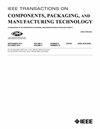Negative Dispersion-Less Coupling Structure and Its Application for Realization of Extremely Small Negative Couplings in Waveguide Filters
IF 3
3区 工程技术
Q2 ENGINEERING, ELECTRICAL & ELECTRONIC
IEEE Transactions on Components, Packaging and Manufacturing Technology
Pub Date : 2025-06-23
DOI:10.1109/TCPMT.2025.3582009
引用次数: 0
Abstract
Negative coupling is widely used in microwave filter design, especially for filters with finite transmission zeros (TZs). Conventionally, negative coupling is realized through capacitive irises or probes. However, when the negative coupling is small, capacitive irises need to be very narrow, which presents significant challenges in manufacturing and tuning the filters. In this article, a negative dispersion-less coupling structure (NDLCS) is proposed based on a partial-height post for waveguide filters. Compared to capacitive irises, the NDLCS achieves a comparable effect while allowing the minimum dimension of coupling structures to increase from tens of micrometers to a few millimeters. The NDLCS also enables the installation of tuning screws, which significantly lowers both the manufacturing difficulty and the sensitivity to manufacturing tolerances. Two waveguide filters with narrow bandwidths are designed using the proposed NDLCS and compared to filters with conventional capacitive irises and dispersive coupling structures. The investigated and measured results demonstrate the advantages of the proposed NDLCS in manufacturing and tuning when realizing small negative coupling for waveguide filters.负无色散耦合结构及其在波导滤波器中实现极小负耦合的应用
负耦合在微波滤波器设计中有着广泛的应用,特别是对于具有有限传输零点的滤波器。传统上,负耦合是通过电容虹膜或探头实现的。然而,当负耦合很小时,电容虹膜需要非常窄,这在制造和调整滤波器时提出了重大挑战。本文提出了一种基于部分高度柱的负无色散耦合结构(NDLCS)。与电容式虹膜相比,NDLCS实现了类似的效果,同时允许耦合结构的最小尺寸从几十微米增加到几毫米。NDLCS还可以安装调谐螺钉,这大大降低了制造难度和对制造公差的敏感性。利用所提出的NDLCS设计了两个窄带波导滤波器,并与传统电容虹膜和色散耦合结构的滤波器进行了比较。研究和测量结果表明,在实现波导滤波器的小负耦合时,所提出的NDLCS在制造和调谐方面具有优势。
本文章由计算机程序翻译,如有差异,请以英文原文为准。
求助全文
约1分钟内获得全文
求助全文
来源期刊

IEEE Transactions on Components, Packaging and Manufacturing Technology
ENGINEERING, MANUFACTURING-ENGINEERING, ELECTRICAL & ELECTRONIC
CiteScore
4.70
自引率
13.60%
发文量
203
审稿时长
3 months
期刊介绍:
IEEE Transactions on Components, Packaging, and Manufacturing Technology publishes research and application articles on modeling, design, building blocks, technical infrastructure, and analysis underpinning electronic, photonic and MEMS packaging, in addition to new developments in passive components, electrical contacts and connectors, thermal management, and device reliability; as well as the manufacture of electronics parts and assemblies, with broad coverage of design, factory modeling, assembly methods, quality, product robustness, and design-for-environment.
 求助内容:
求助内容: 应助结果提醒方式:
应助结果提醒方式:


